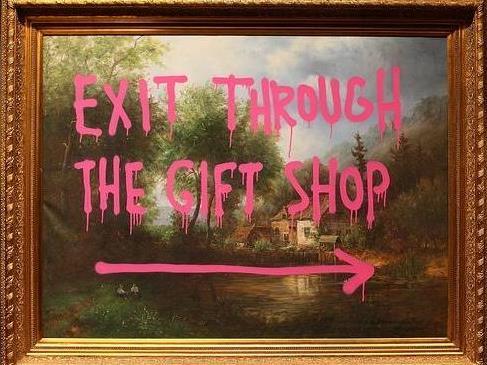An art work by Banksy that was on display at the Bristol Museum in 2009. Image: www.exitthroughthegiftshop.com
Merchandising art is traditionally the province of museums and galleries, its ubiquity wryly captured in the title of Banksy’s film Exit through the Gift Shop.
When you visit a museum or gallery, it’s unavoidable to spend time perusing books, ogling jewellery, sniffing luxe scented candles and handling quirky homewares. You probably don’t need those Mona Lisa coasters, but you take them to counter anyway as something to remember your art experience by.
But what about the individual artist? Is there something in it for them?
‘I thought, why can’t I just have my gift shop?’ said Spencer Harrison, known under the artist name Spenceroni. For his first solo exhibition, Harrison created a pop up shop, or merchandise corner, complete with socks, tote bags, cards, stickers, enamel pins and more.
‘There was a bit of a preconceived idea that it was selling out if you had merchandise for sale, but these days it is good to have these extra revenue streams,’ said Harrison.
Championing art as merchandise in Australia is poet and artist Richard Tipping. Working between image and language, his artworks have been turned into everything from stickers, tote bags, posters and more.
For Tipping, merchandise refers to the mass-produced items made specifically for retail. ‘This art-affiliated stuff is cheap, unusual in some way, and produced in large quantities. As Banksy put it in the title of his film, Exit through the Gift Shop.’
Tipping observes that commercial galleries don’t like merchandise as it detracts from the main task of selling original artworks. ‘Understandably, it’s also a hassle for a gallery dealing with small change. Why have a souvenir available if it’s going to compete with the real works?’
But Tipping believes artists should be excited by the prospect of merchandise. ‘I love seeing my stuff on shelves in an art gallery shop – where it is likely to seen by many more people that any particular exhibition as the exhibition is more temporary than stock in the shop.
‘If you can design merchandise which is in itself counts as artwork, even better! Why not?’
Tipping’s first foray into merchandise was a badge with the design of his work SIGN in 1983.
‘Soon after that I made an Australian Mad badge, using the then standard design for the Australian Made logo with the E missing. These were sold on shop counters using an empty sardine can – the old deep kind with a wind-back key – as the display container. I sold more than a thousand,’ said Tipping.
Artist Matthew Dunn also said merchandise can provide a regular revenue stream and uses the platform Redbubble. When managed properly, a benefit can be that it does not require full-time attention.
‘The more exposure your other projects gain, the larger the audience for your merchandise and vice versa. If you focus on character-centric designs like I do then it also helps to define a visual identity across different platforms,’ said Dunn.





